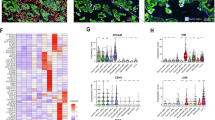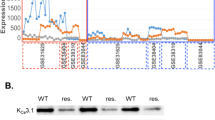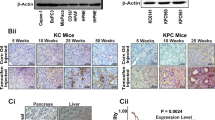Abstract
We describe here two new human urothelial carcinoma cell lines, CAL 29 and CAL 185, established from two patients with high-grade tumours and which display very different properties in vitro. We have shown that CAL 29 cells were tumorigenic in mice and expressed characteristic features of both cell scattering and transition from epithelial to mesenchymal phenotype (EMT) after triggering by the EGF receptor ligands, TGFα and EGF. At the opposite, the CAL 185 cells were not tumorigenic in mice and neither scattered nor expressed vimentin intermediary filaments in the presence of growth factors. We further demonstrated that CAL 29 cell scattering was reversible after growth factor removal and that both scattering and EMT were markedly impaired after treatment with MEK, Src and PI3-kinase inhibitors suggesting that these kinases might be important components of the cellular responses to EGF and TGF-α leading to scattering and EMT. These agents could help to understand the intracellular pathways involved in invasiveness and to find new targets for limiting metastasis. In conclusion, these two new cell lines could be good models to dissect the molecular mechanisms involved in invasion and metastasis development in human bladder cancer. © 2001 Cancer Research Campaign http://www.bjcancer.com
Similar content being viewed by others
Article PDF
Change history
16 November 2011
This paper was modified 12 months after initial publication to switch to Creative Commons licence terms, as noted at publication
References
Behrens J, Mareel MM, Van Roy FM and Birchmeier W (1989) Dissecting tumor cell invasion: Epithelial cells acquire invasive properties after the loss of uvomorulin-mediated cell-cell adhesion. J Cell Biol 108: 2435–2447
Birchmeier C, Birchmeier W and Brand-Saberi B (1996) Epithelial-mesenchymal transitions in cancer progression. Acta Anat 156: 217–226
Boyer B, Tucker GC, Valles AM, Franke WW and Thiery JP (1989a) Rearrangements of desmosomal and cytoskeletal proteins during the transition from epithelial to fibroblastoid organization in cultured rat bladder carcinoma cells. J Cell Biol 109: 1495–1509
Boyer B, Tucker GC, Valles AM, Gavrilovic J and Thiery JP (1989b) Reversible transition towards a fibroblastic phenotype in a rat carcinoma cell line. Int J Cancer 4, Suppl69–75
Boyer B, Roche S, Denoyelle M and Thiery JP (1997) Src and Ras are involved in separate pathways in epithelial cell scattering. EMBO J 16: 5904–5913
Cooper CS and See WA (1992) The impact of iatrogenic urothelial trauma on urinary levels of transforming growth factor-alpha. J Urology 147: 1647–1649
Dutrillaux B and Lejeune J (1971) Sur une nouvelle technique d'analyse du caryotype humain. CR Acad Sci 272: 2638–2642
Gioanni J, Zanghellini E, Mazeau C, Michiels JF, Crafa F, Gugenheim J, Loubiere R, Schneider M and Demard F (1993) An immunophenotyping procedure for human carcinomas using a panel of nine new monoclonal antibodies. Oncol (Life Sci. Adv.) 12: 89–100
Gilles C, Polette M, Piette J, Delvigne AC, Thompson EW, Foidart JM and Birembaut P (1996) Vimentin expression in cervical carcinomas: association with invasive and migratory potential. J Pathol 180: 175–180
Gravilovic J, Moens G, Thiery JP and Jouanneau J (1990) Expression of transfected transforming growth factor alpha induces a motile fibroblast-like phenotype with extracellular matrix-degrading potential in a rat bladder carcinoma cell line. Cell Regul 1: 1003–1014
Hay ED (1995) An overview of epithelio-mesenchymal transformation. Acta Anat 154: 8–20
Imai T, Kimura M, Takeda M and Tomita Y (1995) Significance of epidermal growth factor receptor and c-erbB-2 protein expression in transitional cell cancer of the upper urinary tract for tumor recurrence at the urinary bladder. Br J Cancer 71: 69–72
Khwaja A, Lehmann K, Marte BM and Downward J (1998) Phosphoinositide-3-kinase induces scattering and tubulogenesis in epithelial cells through a novel pathway. J Biol Chem 273: 18793–18801
Lochter A, Galosy S, Muschler J, Freedman N, Werb Z and Bissell MJ (1997) Matrix metalloproteinase stromelysin-1 triggers a cascade of molecular alterations that leads to stable epithelial-to-mesenchymal conversion and a premalignant phenotype in mammary epithelial cells. J Cell Biol 139: 1861–1872
Mellon J, Cook S, Chambers P and Neal D (1996) Transforming growth factor alpha and epidermal growth factor levels in bladder cancer and their relationship to epidermal growth factor receptor. Br J Cancer 73: 654–658
Petit V, Boyer B, Thiery JP and Valles AM (1999) Characterization of the signaling pathways regulating alpha2beta1 integrin-mediated events by a pharmacological approach. Cell Adhes Commun 7: 151–165
Petit V, Boyer B, Lentz D, Turner CE, Thiery JP and Valles AM (2000) Phosphorylation of tyrosine residues 31 and 118 on paxillin regulates cell migration through an association with CRK in NBT-II cells. J Cell Biol 148: 957–970
Ravery V, Colombel M, Popov Z, Bastuji S, Patard JJ, Bel J, Abbou CC, Fradet Y and Chopin DK (1995) Prognosic value of epidermal growth factor-receptor, T138 and T43 expression in bladder cancer. Br J Cancer 71: 196–200
Ruck A and Paulie S (1998) EGF, TGF alpha, AR and HB-EGF are autocrine growth factors for human bladder carcinoma cell lines. Anticancer Res 18: 1447–1452
Savagner P, Valles AM, Jouanneau J, Yamada KM and Thiery JP (1994) Alternative splicing in fibroblast growth factor receptor 2 is associated with induced epithelial-mesenchymal transition in rat bladder carcinoma cells. Mol Biol Cell 5: 851–862
Thiery JP and Chopin D (1999) Epithelial cell plasticity in development and tumor progression. Cancer Metastasis Rev 18: 31–42
Author information
Authors and Affiliations
Rights and permissions
From twelve months after its original publication, this work is licensed under the Creative Commons Attribution-NonCommercial-Share Alike 3.0 Unported License. To view a copy of this license, visit http://creativecommons.org/licenses/by-nc-sa/3.0/
About this article
Cite this article
Cattan, N., Rochet, N., Mazeau, C. et al. Establishment of two new human bladder carcinoma cell lines, CAL 29 and CAL 185. Comparative study of cell scattering and epithelial to mesenchyme transition induced by growth factors. Br J Cancer 85, 1412–1417 (2001). https://doi.org/10.1054/bjoc.2001.2105
Received:
Revised:
Accepted:
Published:
Issue date:
DOI: https://doi.org/10.1054/bjoc.2001.2105
Keywords
This article is cited by
-
ETV5 links the FGFR3 and Hippo signalling pathways in bladder cancer
Scientific Reports (2019)
-
Inhibition of epithelial-mesenchymal transition in bladder cancer cells via modulation of mTOR signalling
Tumor Biology (2016)
-
Expression of the E-cadherin repressors Snail, Slug and Zeb1 in urothelial carcinoma of the urinary bladder: relation to stromal fibroblast activation and invasive behaviour of carcinoma cells
Histochemistry and Cell Biology (2012)
-
Specific protein and miRNA patterns characterise tumour-associated fibroblasts in bladder cancer
Journal of Cancer Research and Clinical Oncology (2011)



